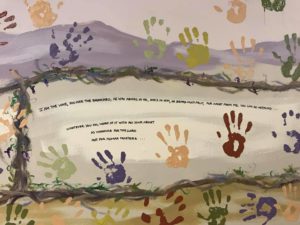Her face was darkened and remained that way for the hour or so that she hovered around me. Her shoulders were hunched, her mood dour, and she was only 11. It was pitiful, and yes, I felt sad for her. But it wasn’t too long before my empathy turned to impatience and then to decisiveness.
We were involving the kids, all 65 of them, at Rise Up!’s after school program. Having saved out an area where they could put their mark on the mural, we were cycling the kids through one by one. This 11 year old angrily eyed everyone else getting their hands in the paint, while she argued with her teacher and then with me. Did she want to be involved? It was hard to know. Six pans of color from the mural palette were set out, but by the time this little friend agreed to get her hand dirty the purple and the red were decommissioned (artist’s prerogative for many kids kept choosing the darker colors).
This really set her off and she was now determined to tell me and everyone else what she had to have. We worked with her, we explained the color balance, we coached her not to miss her opportunity, and finally we were done. 64 hands are on the mural now, but one is missing.
Later that evening I reviewed the afternoon’s project “did I handle that well enough?” “Could we have better helped her be involved?” “What was more important: color balance or wise coaching of an angry child, or a life lesson that may or may not have been going on there?” What struck me as I weighed this was that one resistant child took more emotional energy than all the other 64 kids combined! She was determined not to budge, and she wanted us to know it. We did.
Adamantly, she took her stand “but purple is important to me!” even though she was repeatedly coached that the purple was no longer an option. When I think of stubbornness and insistence, I will think of this little girl’s will. She just could not soften. The time was up, the plates of remaining color were scooped into the trash, and she was surprised to see that her opportunity was really over.
That’s the part that makes me most sad. Things end.
I’m sorry, but the thing that makes me sad is that now, this child will feel excluded the rest of her life only because her preferences didn’t fit someone else’s pattern. Did anyone bother to ask her WHY purple was important to her? She may have had a legitimate reason. It seems mean to me that she couldn’t have purple only “because” – not because paint had run out, but because it didn’t fit the artist’s vision. One handprint wouldn’t have made that much of a difference in the overall design. If the artist was so intent on having a design a certain way, she should have just done it herself rather than involving others. Her purpose was more focused on design than on the people involved.
Dear Cindy,
Thanks so much for reading and for having the guts to speak up. I appreciate your concern for this little one, and I watched concern demonstrated by others there that day for her too. I appreciate your sadness! Did we ask her? Yes, we tried, and tried. You’re right, it would have been tons easier not involving the kids that day and days earlier. There were some really cool things that happened because we did. Those kids who jumped in now “own” this project in a way that wound’t have happened unless we had.
It’s a fair critique that the artist (me, mainly) was more focused on the design than the kids. That’s why I depended and took cues from the staff who do an amazing job with these kids. They asked me to execute the design. I worked out of my strengths and depended on the team to help me with my weak areas. We did this as a group. Not perfect, but 64 out of 65 isn’t bad. One heart is worth a lot more than a number though. This little girl is part of the program and being shepherded pretty well.
Thanks so much for a great comment.